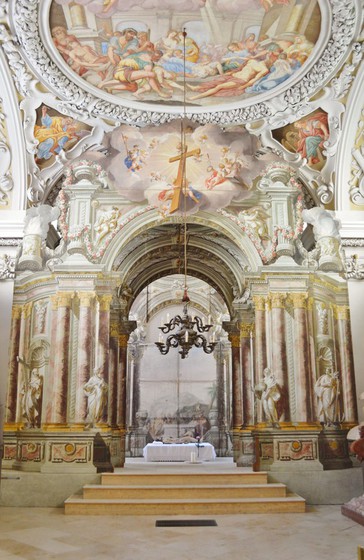Johann Wenzel Bergl
( * September 23, 1719 in Dvůr Králové nad Labem, † January 15, 1789 in Vienna) was an important painter and decorative artist of the late baroque and rococo.
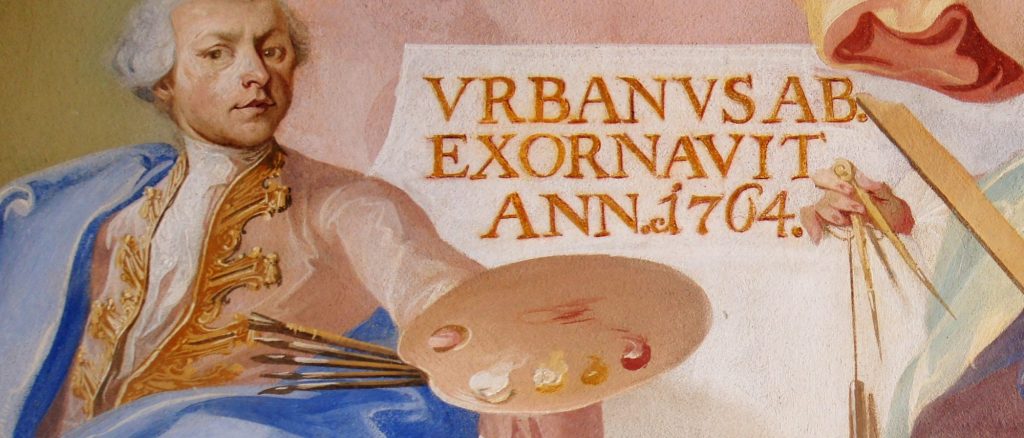
He mainly derived his fame from his fantastical landscape paintings which he did for the aristocracy and the clergy. The church of the former Benedictine monastery of Mariazell im Wienerwald is regarded as his most important sacred work while the frescos at the garden pavilion of Melk Abbey are his major secular work. In his homeland of Bohemia, expressive scenes of the Via Crucis bear witness to his artistic creativity. He is less known for his work as a painter of ephemeral architecture such as the Holy Sepulchre at Losensteiner chapel in the former Benedictine monastery of Garsten in Upper Austria.
His life
Bergl was born on September 23, 1719 in the North-Bohemian town of Dvůr Králové nad Labem. The house he was born in was located close to the local church but no longer exists. His presence in Vienna is confirmed from the 1740s onwards. On May 19, 1754 Bergl married Theresia Märsch, the daughter of the civic painter Johann Bernhard Märsch, in the parish of Saint Ulrich. The Academy painter Franz Anton Maulbertsch, who was also important for Bergl artistically, was witness at the wedding. The couple had eight children, three of them survived their father and were named in his last will and testament: Academy painter Anton, miniature painter Johann as well as their underage sister Theresia Bergl. All three of them lived at the address of their deceased father in the Spittelberg house “Bei den 7 Kurfürsten”. The coroner’s report of the City of Vienna dated January 15, 1789 gave “Verstopfung der Leber” (constipation of the liver) as the cause of death.
Artistic career
The first indication of Johann Wenzel Bergl as a painter can be found in the enrolment protocols of the Vienna Academy in the year 1749. The institution had been closed between 1745 and 1749. When it was reopened on October 20, 1749, the index of names mentioned Bergl as an artist “living at the ‘Schwarze Adler auf der Wendlstadt’”. It can therefore be assumed that he had already received artistic training prior to his time at the Vienna Academy. He probably contributed to the Sala terrena at the Benedictine monastery of Altenburg, particularly to its bizarre “Chinese room” (around 1745/47).
In 1751 he was awarded the second prize in the category Painting by the Vienna Academy; one year later, on October 27, 1752, he won the first Court prize. This award also meant that he was now independent of the guild and was allowed to engage his own assistants. Surprisingly, Bergl did not make use of this possibility at first. Instead he worked on joint projects which he probably carried out in collaboration with his friend and companion Franz Anton Maulbertsch. Maulbertsch (who had himself won an award from the Academy in 1750) became one of Bergl’s defining role models. They both shared a passion for intense examinations of the possibilities of grand and glimmering colouring side by side with a weakness for expressive figures.
In the second half of the 1750s and early 1760s, Bergl created Stations of the Cross at Dvůr Králové (around 1757), Orlice (1759) and for the Capuchin church at Opočno (1763) in Eastern Bohemia.
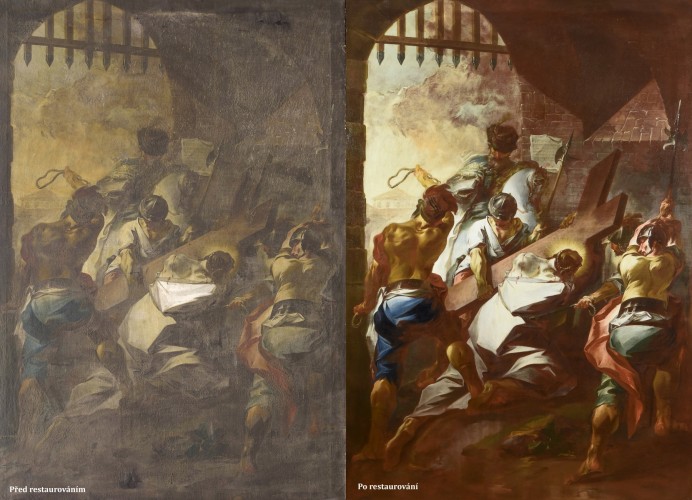
Bergl did his most important sacred work at the church of the former Benedictine monastery of Mariazell im Wienerwald (1758/59): After having been overshadowed by Maulbertsch for several years in near anonymity, the artist unexpectedly and self-confidently moved into the limelight. His first work already showed Bergl’s main talent for the “decorative” (without any negative connotation). It is not so much the details of the paintings that attract the viewer into getting lost in them. Instead, the painted framings and the lively figures melt into a strong and ornamental overall effect.
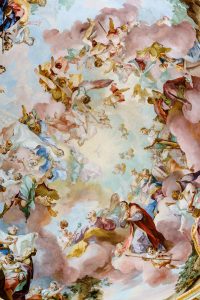
Bergl came into contact with the “kaiserliche Hofbauamt”, the Imperial body dealing with construction, maybe by arrangement from his father-in-law, the decorative painter Johann Bernhard Märsch. The first assignments were carried out in the form of cooperations, for example on the “Grünnehaus” at Laxenburg where Bergl worked together with Maulbertsch epigone Andreas Brugger in the years 1760/61. In 1762/63 he worked alone on the decoration of six rooms at the Episcopal Summer Palace at Ober-St. Veit which Maria Theresa had just purchased. His paintings of an exotic fauna and flora were an assignment that was of great importance to his future career. He used the famous French tapestry series “Nouvelles Indes” by Alexandre-François Desportes as a reference. Elements from these tapestries such as groups of animals, fruit baskets or inhabitants of this seemingly foreign scenery are incorporated into a new coexistence and community according to aesthetic criteria. Palms trees, banana plants, vines and cashew trees are forming a roof made of leaves and appear to negate the boundaries of the room. Later on, Bergl repeated this theme in the garden pavilion of Melk Abbey (1763/64) , the Hofburg (1766), Schönbrunn Palace (around 1770, 1773/74) and Donaudorf Palace (1773). Eventually, his handling of these motives became ever more free: In the apartments of Schönbrunn Palace he no longer painted illustrating figures and animals but vases and architectures using antique elements as well as treillages.
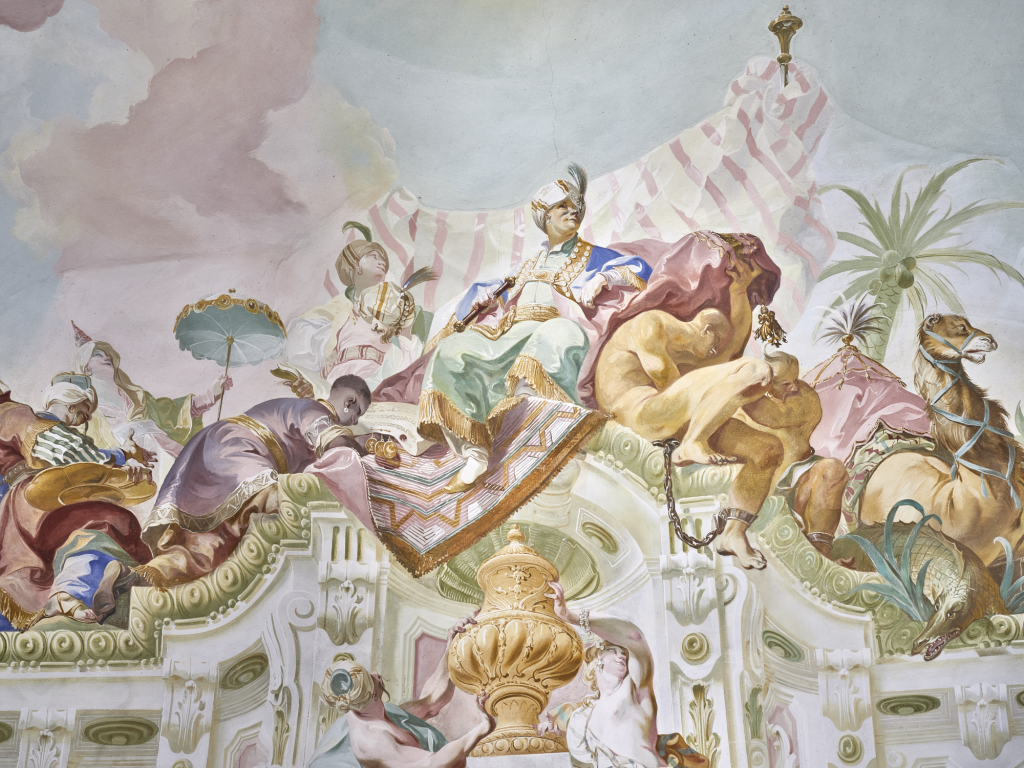
Bergl was working for many monasteries. It was in particular Melk Abbot Urban II Hauer who acted as his patron. After the assignment for the garden pavilion (1763/64), he commissioned the painter with the decoration of the prelates’ Summer Palace at Pielach (1766/67), the frescos in the upper library halls of the monastery (1767), the chapel of the Vienna Melkerhof (1773), the prelature chapel at Melk Abbey (1782) as well as with smaller work such as the painting of the monastery’s guest rooms or paintings for the parishes belonging to the monastery. He also did work for the Order of Saint Elisabeth at Vienna Landstrasse, the Cistercians at Neukloster, Wiener Neustadt, the Servites at Schönbühel, the Paulines at Felsö-Elefant, Maria Család and Budapest, the Augustinians in Vienna, the Premonstratensians at Klosterbruck, the Benedictines of the Vienna Schottenstift, as well as for Seitenstetten, Altenburg (pilgrimage church of Maria Dreieichen) and Garsten. Bergl’s Holy Sepulchre at the Losensteiner chapel of the former Benedictine monastery of Garsten is particularly special since ephemeral architectures like this one usually did not survive for long because of the nature of the materials that were used. With restoration work completed, his illusionistic scenic architecture can be viewed in situ during the Easter period.
